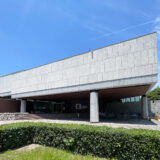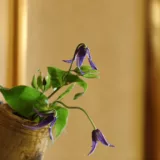The second of Kogei Art KYOTO’s recommended spots in Kyoto is the Kyoto Gyoen National Garden, which is located in the city center.
Kyoto Gyoen as seen from Marutamachi St.
The Kyoto Gyoen National Garden was originally the location of the Kyoto Imperial Palace, which was the residence of the Emperor for over 500 years. The area around it was home to the mansions of the nobility.

After the Meiji era, the emperor moved from Kyoto to Tokyo, and the remaining nobleman’s residences were demolished. Trees were planted to create a park, which is now the Kyoto Gyoen National Garden.


Within the Kyoto Imperial Palace Garden, which covers a vast area of 100 hectares, the Kyoto Imperial Palace, along with the Kyoto Omiya Imperial Palace and the Kyoto Sento Imperial Palace, is still being maintained and retains its former appearance.
In 2005, the Kyoto State Guest House was also built in Kyoto. This city symbolizes Japanese history and culture as a facility to welcome guests from overseas with all our hearts and to deepen their understanding and friendship with Japan.
Together with these facilities, the Kyoto Imperial Palace Garden is widely popular with tourists from Japan and overseas and local citizens as a place to relax.
The garden is home to a diverse and rich forest, with around 50,000 trees and over 500 plant species. You can also see an amazing variety of wildlife, including over 100 species of wild birds, over 50 species of butterflies, and over 400 species of mushrooms.
Therefore, you can enjoy Kyoto Gyoen National Garden in any season, but we especially recommend a walk in the early morning on a fine day.
There are not many visitors at this time of day, so you can experience the rich nature even more and feel the place’s long history in the quiet atmosphere.




I also recommend the Kyoto State Guest House, which is located within the Kyoto Gyoen National Garden.
The highlights are the irimoya-style roof(hipped roof with a gabled, hipped roof) and sukiya-style(Tea-ceremony style) exterior, which are traditional Japanese residential styles, and the many traditional Kyoto crafts used in the building and furnishings, such as sukiya carpentry, plastering, garden design, kirikane, Nishijin textiles, maki-e (gold or silver lacquer), and lacquer.
At the Kyoto State Guest House, English-guided tours can be booked in advance online.
In addition, it is possible to apply on the day to visit the Kyoto Imperial Palace throughout the year. There are also guided tours in English twice a day.
There are also four free rest areas in the garden, which have restaurants, cafes where you can enjoy sweets, souvenir shops, etc., and clean toilets in various places, so you can spend a whole day there.




